News
How form is a factor
April 27, 2005
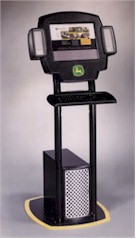 |
Kiosks have come a long way in the past 25 years. The first public access kiosk in fact was developed at the University of Illinois at Urbana-Champaign and deployed in April of 1977. Interestingly enough, that first kiosk consisted of only a touchscreen and a keyboard perched on a pedestal. Since the kiosk was connected to the University's LAN, there was no need for a CPU.
Today, kiosks come in various sizes, shapes, colors and materials. A survey of various vendors in the kiosk marketplace helps chronicle the evolution of kiosk enclosures. "Twenty years ago, most enclosures were made out of laminated particle board," says Allen Buchholz, executive VP of Frank Mayer and Associates, Inc. (FMA) (Grafton, WI). The company is a designer and producer of custom kiosk enclosures. In-house capabilities include designing, engineering, prototyping production and software/hardware integration. The family-owned company started more than 70 years ago in the permanent point-of-purchase and merchandiser industry.
Particle board, at the time, was a cost-effective method of producing ten or 20 kiosks. "As the quantities required for a project grew into the hundreds or even thousands, a designer or engineer could be much more creative with steel and vacuum-formed components," adds Buchholz. Another major impact on kiosk design over time has been the size of kiosk components. According to Buchholz, "As touchscreens and computers get thinner, so does the enclosure. Enclosures today take on the slim shape of their internal components."
 |
Particle board is definitely a thing of the past in the kiosk enclosure industry. "Companies still delivering wooden prototypes and production kiosks are a dying breed," notes Tom Weaver, vice president of sales and marketing for Louisville, CO-based Kiosk Information Systems (KIS). The company designs and manufactures touchscreen, self-service kiosk solutions for retail, human resources, employee benefits, CRM, Wi-Fi, loyalty, gaming and other self-service applications.
KIS provides more than 28 standard kiosk models, custom models and turnkey vending units such as public Internet terminals and photo kiosks. Weaver notes that powder-coated metal is used an overwhelming percentage of the time. Kiosk enclosure production is streamlined and faster. "Renderings are done in hours, prototypes in days," he says. "Standard enclosures which support a wide variety of tailored configurations are the workhorses now. Speed of delivery and cost are critical components." Weaver uses Wal-Mart as an example. "Initially three different prototypes or design iterations were created, all in the space of ten days. Main production was 2,700 units manufactured, tested and shipped in less than six weeks."
Jim Whitmore is ITS program manager for Rittal Corp., based in Springfield, OH. The company, part of Rittal International, is an enclosure manufacturer with offices in more than 70 countries. Rittal offers a wide range of products such as industrial cabinet systems, 19-inch electronic components, power distribution systems, data communication platforms, kiosks and outdoor enclosures. Whitmore agrees that the kiosk form factor is shrinking as the basic kiosk components become smaller. Innovative kiosk designs, however, allow for additional components, such as bill acceptors and receipt printers. He also adds that in today's society, compliance with laws, such as the Americans With Disabilities Act (ADA), can affect kiosk enclosure design, especially in public, government-based projects. "Most people think of ADA compliance as wheelchair-accessible screens," says Whitmore, noting that compliance includes making kiosks usable by persons with hearing and/or visual impairments.
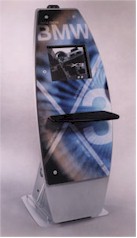 |
Kiosk serviceability has also become more complex as kiosks enclosures have evolved. No longer simply a computer on a pedestal, today's kiosks must be sturdy enough to withstand constant use, weather elements and vandalism. Like virtually all mechanical items, kiosks will break down. "Kiosk components must be installed in the enclosure so they can be easily taken out for repair," notes Whitmore. And it's not just repairs; consumables (paper and ribbons) must also be replaced and bill acceptors must be emptied. Therefore, paper trays, printers and bill trays should be easily accessed, yet secure.
Weaver, of KIS, cites the use of the Cricket units by Info Touch in convenience stores. "Some of the bigger considerations were the security of the lockboxes and to engineer them to be totally secure. Then, paradoxically, turn around and make sure those same units are easily serviceable by cash pickup/service people. It's an age-old dilemma." Weaver also provides the example of hiring kiosks used by mega-retailers, "Units are placed in variable areas but close to entry doors and used by a very wide demographic. Totally unattended, these units are built like tanks to survive the abuse that is inevitable."
Kiosk enclosures have evolved to the point that the kiosk itself can represent a brand or a company, simply by design. Buchholz, of FMA, offers one such example: "The BWM Virtual Sales Center is a great example of how design, materials and software content all work to extend the brand image of the BMW automobile. A premium product must be presented in a premium enclosure."
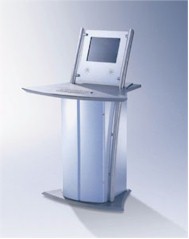 |
"The greatest consideration to make is how important the brand image of the product or service the kiosk is selling," adds Buchholz. "Most brands spend great care and great dollars establishing and nurturing a brand image. When a kiosk is chosen as a marketing tool, the same care must be taken to nurture that brand image."
Buchholz notes that brand marketers are learning that they must use a custom enclosure to support their brand. "Stock units simply confuse customers if there aren't sufficient add-ons to boost the brand. There were many marketers in the past who wanted to do a custom kiosk enclosure to reflect the brand image, but wanted to save the cost of development of that custom enclosure until after a test market," says Buchholz. He questions the reliability of a test-marketed brand without the custom enclosure.
When it comes to kiosk enclosure criteria, Weaver's list includes establishing design criteria; evaluating engineering requirements; setting integration requirements; and reviewing delivery, support and maintenance options.
Whitmore recommends considering environmental factors. "You can never use wood outside," says Whitmore. "We work with aluminum and steel in any color." He notes that metal is not just an outdoor medium, even though his company is receiving more requests for secure, outdoor kiosks. While metal kiosks offer a high-level of security because they can be sealed, they can also be light weight and easily moved within stores, for example.
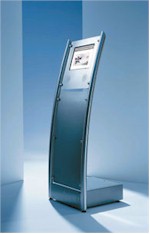 |
Sydney Afrin, vice president of SeePoint Technology (Redondo Beach, CA), designs, manufactures and deploys vandal-resistant hardware solutions for businesses that provide Internet access, self-service transactions, information dissemination and data collection. The company offers a full line of off-the-shelf touchscreen products, which may be customized with color, logos and silk screens for private labeling and branding opportunities. "The single biggest mistake made in the design, manufacture and/or installation of kiosk enclosures is sacrificing long-term considerations - most importantly system reliability - for short-term cost savings," points out Afrin. "Most kiosk customers don't realize that the biggest cost of a kiosk deployment is hidden. If a customer chooses a low-cost but more unreliable or less robust kiosk system, such as a desk-top computer in a cabinet, the cost of supporting and maintaining the system over the long haul may be exponentially greater that the cost of purchasing the system."
When it comes to kiosk placement, just as in real estate, location is everything. "Too few or poorly located kiosks indicate to a potential user that the kiosks are not important or useful enough to warrant a prime location, and thus, are not worth using," says Afrin. "Similarly, kiosks which are not visible to potential users or which have insufficient signage do not get used."
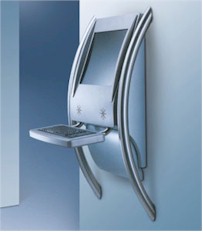 |
Signage, or advertising, can be a boon when used on a well-placed kiosk. Kiosk owners can sell advertising space on their kiosks or use the space to encourage kiosk users to buy additional products or services, notes Whitmore. Attracting users isn't always a concern. Kiosks used in large corporations for human resource functions (benefit changes, pay stub retrieval, vacation requests, etc.) don't require many bells and whistles. Proper placement and easy access are key, rather than company logos and slick design.
As times change, kiosk enclosures are certain to change over time as well. Smaller form factors, new colors, perhaps even flashing lights, will invite users to experience what future kiosks have to offer. But even though times may change, Afrin offers some kiosk advice that may well stand the test of time: "In the end, anything worth doing must be done right. Any company considering a kiosk deployment must be prepared to invest in the short- and the long-term success of the project."
Research
www.fmakiosks.com
www.kis-kiosk.com
www.rittal.com
www.seepoint.com
Originally published in the May/Jun 2004 issue ofKiosk magazine.
[Editor's note: Info Touch Technologies became Tio Networks in April 2006.]










